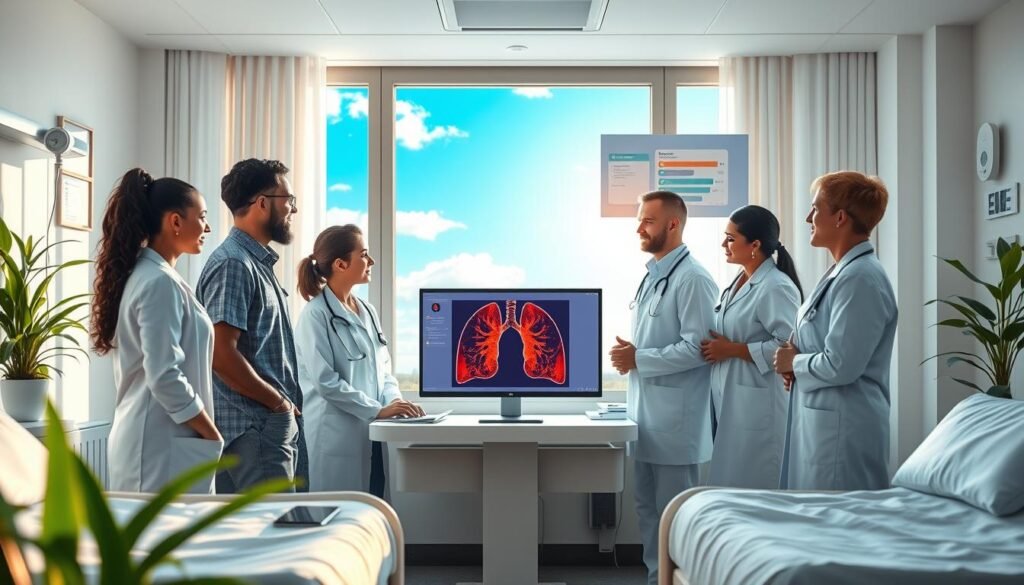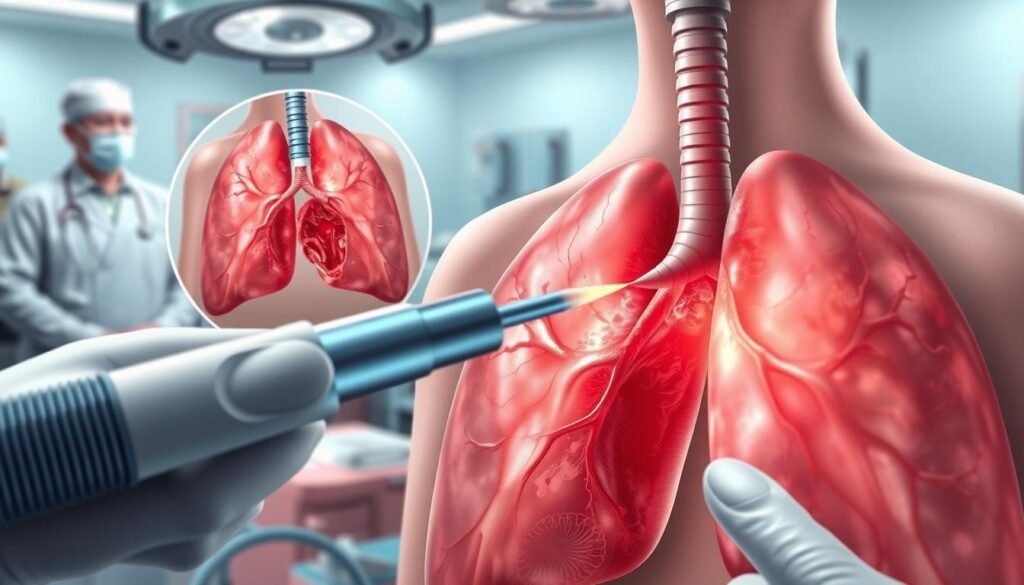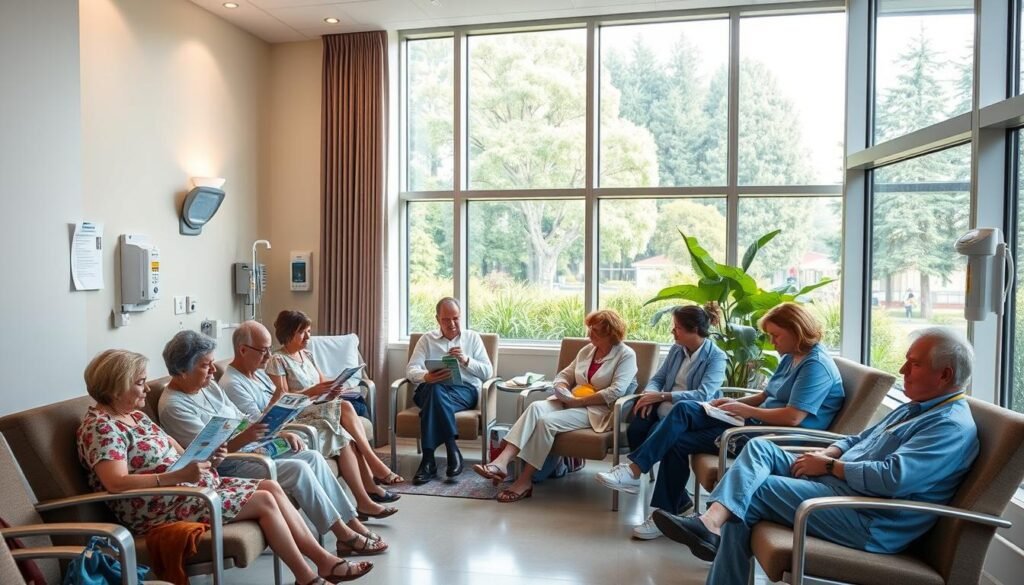Lung cancer is the top cause of cancer death in the United States. About 1 in 16 people will get it in their lives. It’s vital we understand how to catch lung cancer early to save lives.
The best chance at beating this disease comes with early diagnosis. Regular checks are key for anyone, especially those at higher risk. This helps catch the illness early when treatment works best.
Low-dose CT scans are the best way for high-risk individuals to get checked. This is mainly for those who have smoked a lot in the past. These scans are better at finding lung cancer early than chest x-rays, which don’t help much with survival rates. Knowing what signs to look for is also crucial.
Key Takeaways
- Lung cancer leads cancer deaths in the U.S.
- Low-dose CT scans are top for early detection.
- Chest x-rays don’t help much in screenings.
- People with a heavy smoking background need yearly checks.
- Spotting cancer early greatly increases chances of successful treatment.
- Knowing risks helps with prevention.
Understanding Lung Cancer and Its Risks
Lung cancer is a major health issue, causing many cancer deaths worldwide. About 80% of these deaths come from smoking. Carcinogens in smoke harm lung tissues, which can lead to cancer.
Radon gas is the second leading cause of lung cancer in the U.S., says the US Environmental Protection Agency. It can build up in homes, especially basements. Knowing about it is key. People who have worked with asbestos have a much higher risk of lung cancer. Asbestos irritates the lungs and can cause cancer.
Other risks include chest radiation therapy for other cancers and outdoor air pollution. These account for 1% to 2% of lung cancer deaths. Also, having parents with lung cancer slightly raises your own risk, pointing to a genetic link.
Lately, the dangers of *marijuana smoke* are getting noticed because it has harmful tar and carcinogens, like tobacco does. E-cigarettes, though seen as less harmful, pose serious health risks including *lung damage*, the FDA warns. Knowing these risks helps in avoiding lung cancer.
The Importance of Early Detection
Finding lung cancer early is key to beating it. When caught early, patients have a much better chance to survive. They can get surgery or targeted treatments. Sadly, only 21% of lung cancers are found early. This is often because there are no clear signs at first.
Screening, especially with low-dose CT scans, can really change the game for those at risk. A big study showed that these scans can cut the death rate from lung cancer by 20%. It proves how vital early screening is for people who are more likely to get the disease. It can catch problems before they grow.
That same study found that 63% of lung cancers caught by these scans were at the earliest stage. Early stage means treatment is more likely to work. Only about 30% were discovered in later stages, III or IV. Regular checks can move the needle toward finding cancer early. This improves chances of survival.
In the end, knowing when to screen for lung cancer makes a huge difference. The U.S. Preventive Services Task Force recommends yearly screenings for adults aged 50 to 80. This is really important for people who smoke or used to smoke. It’s a big step in fighting lung cancer.
What Detects Lung Cancer: Screening Methods
Screening for lung cancer early is key to better treatment results. Knowing about the screening methods can help people choose wisely for their health.
Low-Dose CT Scans
Low-dose CT scans are the best for finding lung cancer early. This is especially true for those at high risk. The American Cancer Society suggests them for adults 50 to 80 with a heavy smoking history. These scans can spot tumors early and save lives, making them a top choice for screening.
Chest X-Rays
Chest x-rays were once common for lung cancer screening. But, they often miss small tumors and don’t boost survival rates. They have some uses but aren’t enough on their own for finding lung cancer early.
Sputum Cytology
Sputum cytology checks phlegm for cancer cells. It’s not reliable enough by itself for early lung cancer detection. It highlights the need for better methods like low-dose CT scans. For more on lung cancer signs, visit this useful link.
Lung Cancer Symptoms to Watch For
It’s vital to know lung cancer symptoms for quick action. Catching it early helps treat it better and can save lives. Knowing what symptoms look for helps people get checked earlier, leading to better health results.
Common Symptoms
Here are the symptoms often seen in lung cancer:
- Persistent cough
- Chest pain
- Shortness of breath
- Wheezing
- Coughing up blood
These symptoms might look like other less serious conditions or be thought to come from smoking. This can cause delays in finding out it’s cancer. Lung cancer symptoms can take a while to show up. This is especially true for non-small cell lung cancers. When they do appear, the disease may be in a late stage. Also, odd symptoms like muscle cramps or high blood calcium levels might happen.
When to See a Doctor
If you’re having these symptoms a lot, see a doctor. This is very important for people who have smoked or been around things that can cause lung cancer. Getting checked early can make a big difference in treatment and health. For more details on lung cancer symptoms, check out this resource.
Lung Cancer Screening Guidelines
Lung cancer screening guidelines aim to find cancer early in high-risk groups. The American Cancer Society recommends yearly screenings with low-dose CT scans for those 50 to 80 years old who smoke or have smoked heavily. A 20-pack-year history shows substantial smoking exposure, measuring both duration and intensity.
The 2023 guidelines update seeks to include more people and promote stopping smoking. Studies show former smokers still face a high lung cancer risk up to 15 years after quitting. Extending screening to those who quit longer ago could save more lives.
Screenings use low-dose CT scans, balancing the benefits against radiation risks. Thanks to better CT technology, radiation is lower. However, few eligible people get screened. Only 14.4% of them did before the 2013 USPSTF criteria.
Here are the current lung cancer screening guidelines:
| Criteria | Details |
|---|---|
| Age Range | 50 to 80 years |
| Smoking Status | Current or former smokers |
| Pack-Year History | At least 20 pack-years |
| Health Status | No significant health issues limiting treatment options |
| Screening Frequency | Annually |
It’s crucial to discuss lung cancer screening options together. This ensures people understand the pros and cons, including the risk of false positives or overdiagnosis.
Benefits of Lung Cancer Screening
Lung cancer screening is key for those at high risk. It offers more than finding cancer early. Through regular checks, it raises survival chances and finds cancer early on. This early discovery helps pick the best treatment options, improving patients’ outlooks.
Increased Survival Rates
Lung cancer is a major concern in the U.S., causing 28% of all cancer deaths. Its five-year survival rate is just 17%. But, early detection can boost this to 52% for cancers caught locally. Screenings every year lead to better chances of survival, making them vital.
About 3 out of 1,000 people screened yearly avoid dying from lung cancer. The National Lung Screening Trial showed screening 320 high-risk individuals saves one life from lung cancer. Two studies found that screenings with LDCT cut lung cancer deaths by 20%.
Detection of Early-Stage Cancer
Finding cancer early is crucial for choosing the right treatment. Early-stage diagnosis may mean less harsh treatments, improving life quality. Screening aims to spot lung cancer before symptoms show, allowing for quick action.
Here’s how lung cancer screening impacts early detection and treatment:
| Screening Method | Five-Year Survival Rate | Risk Reduction of Lung Cancer Mortality | Potential Complications |
|---|---|---|---|
| LDCT Screening | 52% (localized) | 20% reduction in mortality | False positives (23.3% in trials) |
| Chest X-Ray | Not effective | No reduction in mortality | False positives (5%-10%) |
| Sputum Cytology | Not effective | No reduction in mortality | False positives (uncertain magnitude) |

Welcoming screening moves us forward in catching lung cancer early. This leads to more successful treatments and better survival odds.
Potential Risks of Screening Tests
Lung cancer screening is key in spotting cancer early. But we must not ignore its risks. Knowing these helps people make careful health decisions.
Radiation Exposure
Low-dose CT scans (LDCT) come with radiation exposure risk. The radiation from LDCT is much lower than a regular chest CT scan. Yet, it equals six months of natural background radiation for the average American. Too many scans can lead to more radiation exposure. This raises concerns about long-term effects.
False Positives and Unnecessary Procedures
False positives add complications to lung cancer screenings. About 12-14% of initial tests may give false positive results. This can cause more tests and procedures, like biopsies. These necessary steps for a correct diagnosis carry their own risks. Even though false positives lessen to about 6% in later tests, any irregular result can cause worry. It highlights the need to understand these risks.
Lung Biopsies in Lung Cancer Diagnosis
Lung biopsies are key in confirming lung cancer. This happens after chest X-rays or CT scans show something unusual. These biopsy procedures get tissue samples from the lungs. This is to check for cancer cells. Biopsies, like needle or open biopsy, depend on the tumor’s size and place.
A biopsy is done for many reasons. It checks imaging results, diagnoses infections, and tells if a mass is cancerous. Knowing the best biopsy method is crucial for treatment and care.
However, lung biopsies are not without risk. Open biopsies can cause blood loss or infection. Needle biopsies might lead to a collapsed lung or bleeding. Yet, with good planning, these problems can often be avoided.

Preparing for a biopsy involves fasting for eight hours and telling doctors about any allergies or medicines. During the procedure, patients are positioned carefully. They receive local anesthesia and imaging helps guide the biopsy. Afterwards, doctors apply pressure to stop any bleeding. This shows the careful steps taken in biopsy procedures.
The Role of Smoking History in Detection
Smoking history is vital in assessing lung cancer risk. It shapes screening recommendations. 87% of lung cancer deaths in the U.S. are linked to cigarette smoking. People who have smoked 20 pack-years or more have a much higher risk.
During a study, current smokers had a lung cancer rate of 1.97 per 1,000 person-years. Former smokers had a rate of 1.61. This is much higher than the 0.26 rate in those who never smoked.
Even after quitting, heavy smokers still face a risk of lung cancer. The risk is higher the sooner after quitting. For instance, those who quit less than five years ago have a hazard ratio of 12.12. Over 40.8% of lung cancers in former smokers occur after 15 years of quitting. This is beyond today’s screening guidelines.
Knowing a patient’s smoking history does more than assess risk. It helps focus on those most at risk. This makes early detection more effective. Each year, smoking causes about 1.69 million lung cancer deaths worldwide.
Studies support screening based on smoking history. This approach, along with stopping smoking, can reduce lung cancer death risks by up to 38%. Despite a drop in smoking rates, the risk for former smokers remains significant.
Healthcare systems like Duke University assess smoking history in clinical records. This guides screening and helps with tobacco quitting strategies. It supports individuals in their quitting journey and helps prevent lung cancer.
| Years Since Quitting (YSQ) | Hazard Ratio (HR) | Lung Cancer Risk |
|---|---|---|
| < 5 YSQ | 12.12 | Highest risk |
| 5–9 YSQ | 11.77 | High risk |
| 10–14 YSQ | 7.81 | Moderate risk |
| 15–24 YSQ | 5.88 | Lowered risk |
| ≥ 25 YSQ | 3.85 | Lowest risk |
Follow-Up Procedures After Screening
After a lung cancer screening, follow-up procedures are key for individual health and safety. Most nodules found by low-dose computed tomography (LDCT) are not cancerous. They need careful watching instead of quick action. If tests show something unusual, the lung cancer screening follow-up may include more scans or lung biopsies to check for cancer.
The timing for follow-up checks varies. It depends on nodule features like size and location, and the patient’s health past. Small nodules, 5 mm or less, are seen as low-risk. Yet, solid nodules or those that are partly solid suggest a higher chance of cancer. Nodules in the upper lobes or those growing quickly need extra attention. The Lung CT Screening Reporting & Data System® (Lung-RADS®) helps decide if a nodule might be cancer, guiding next steps.
After screening, more tests might be done to figure out the cancer stage, if present. Early-stage cancer might be treated with surgery or targeted radiation. For advanced cancer, targeted drugs or immunotherapy might be used.
Following up after screening is critical. Yet, a study showed only 42.6% kept up with suggested follow-ups. This rate changed a lot by Lung-RADS category. For example, only 30% with Lung-RADS 3 followed through, but 68% did when their results were more worrying. Smoking habits and ethnic background greatly affected follow-up rates. This shows the challenge of keeping diverse groups of patients engaged in their care.

Resources for Lung Cancer Awareness and Support
Many resources exist for those seeking information and help with lung cancer. The American Lung Association offers materials on lung cancer types, causes, risk factors, and current research. Their educational resources are key for understanding lung cancer screening, symptoms, and treatment options.
Support groups are vital for people touched by lung cancer. They provide a safe place for patients, caregivers, and survivors to share experiences and find support. This kind of emotional support can really help improve life quality during treatment and recovery.
Organizations like LUNG FORCE help raise awareness and fund research through their initiatives. They organize events nationwide. These events educate people and create a sense of empathy and unity among participants.
Finding detailed lung cancer resources can help people stand up for their health. Knowing about support groups and awareness efforts can bring comfort and motivation. Using these resources can make a big difference in dealing with the disease, both emotionally and in understanding it.
| Resource Type | Organization | Description |
|---|---|---|
| Lung Cancer Resources | American Lung Association | Provides educational materials on lung cancer, including screening and treatment options. |
| Support Groups | LUNG FORCE | Offers a network of support for patients and families affected by lung cancer. |
| Awareness Initiatives | National Lung Cancer Partnership | Conducts events to increase awareness and research funding for lung cancer. |
Conclusion
Knowing how to spot lung cancer early is key to helping patients and promoting health action. Using low-dose CT scans for screening can lower death rates by 20%. This was found in the National Lung Screening Trial. Encouraging people at high risk to get scanned regularly makes a big difference. This way, more people can fight the disease successfully.
Lung cancer leads to 28% of all cancer deaths in the US, making screening super important. The chance of surviving five years after finding lung cancer early is 52%. Making everyone aware of what to watch for can save lives. This helps catch the disease early, especially in communities.
Healthcare providers and patients need to work together to beat lung cancer. Keep teaching and supporting everyone involved. This helps patients take control and learn what steps to take early on. Our goal is to improve chances of survival for everyone facing this challenge.